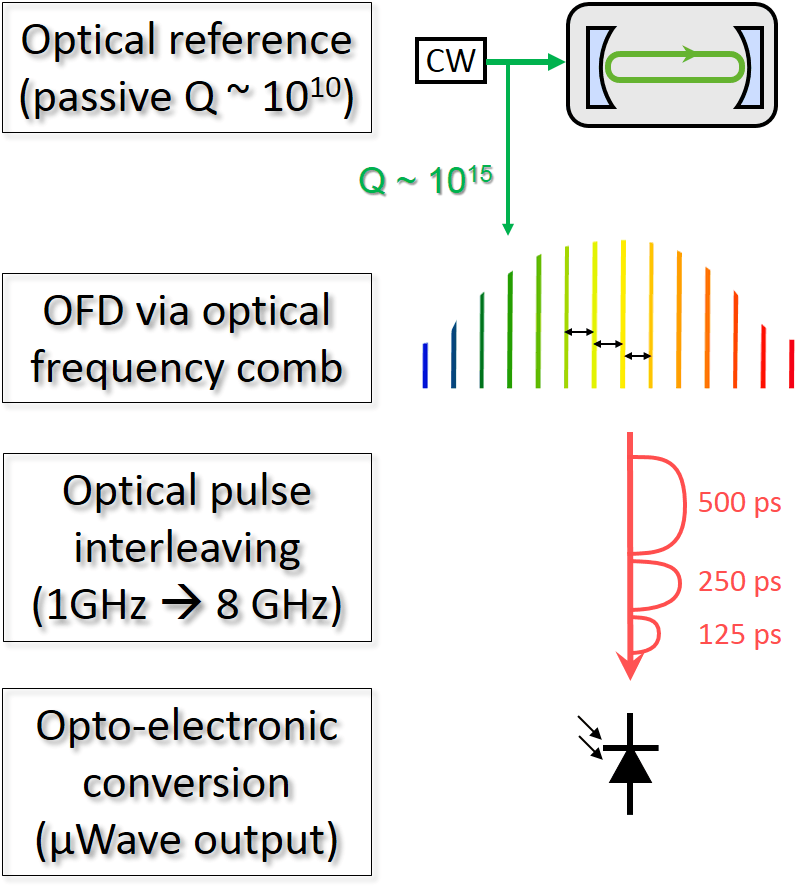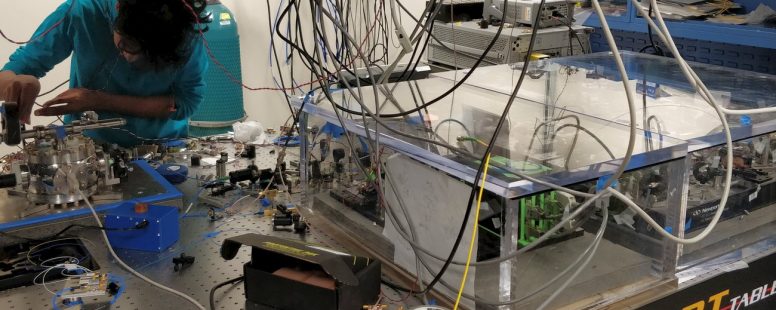Photonic Microwave Generation
Every year, more than two billion quartz crystals are sold on the global market. Most of these are used in consumer devices, such as wrist watches, computers and cell phones. Such oscillators are reliable and cheap, but provide limited performance due to mechanical loss in the quartz crystal itself. There is large variety of other electronic oscillators, though all of these are ultimately limited by material loss at microwave frequencies or other device constraints. This leaves a large number of applications without the appropriate oscillator. Think for instance of 5G test equipment, software-defined radios, radar, navigation and arrayed imaging and the likes.
Photonic microwave generation that is based on the optical frequency division (OFD) approach utilizes optical instead of electronic resonators. Such optical devices offer passive quality (‘Q’) factors in excess of 10E10. This translates into ultra-stable lasers (<1 Hz linewidth @ 192 THz) that can be phase-coherently divided down to the microwave domain with an optical frequency comb. One of our research projects at CU Boulder aims to make this transformational work, that was initiated by colleagues at NIST, into a practical and reliable source of ultra-low phase noise microwaves for precision measurements and sensing applications.

Ultra-low noise microwave generation via Optical Frequency Division (OFD) typically relies on a mode-locked laser, which serves as a frequency divider for a continuous wave (cw) laser, which is actively referenced to an ultra-stable optical cavity. OFD systems are not bound to the material loss at microwave frequencies, but are limited by (typically very low) optical losses, residual quantum noise, SNR of the frequency comb’s error signals, and by flicker noise in the photo-detectors. It was demonstrated earlier [1,2] that these limitations can result in orders of magnitude better phase noise performance than what is typically possible with electronic oscillators. However, despite the apparent simplicity, OFD systems as depicted in Fig. 1, they tend indeed to be very complex (see featured image), require a vacuum system for the reference cavity, and demand significant amounts of electrical power (≥ 50 W). Long-term stability can be an issue as well due to the overall system complexity.
Part of our research is geared towards making OFD a practical approach to ultra-low noise microwave generation. For this work we rely on the excellent noise performance of our MMLL, i.e. it will be an OFD system without the need for a high-finesse reference cavity in vacuum and without the need for phase-stabilizing the frequency comb. (Note that self-referencing a diode-pumped, high-repetition-rate mode-locked laser typically requires ~10-times the wall-plug power, compared to a free-running oscillator.) This free-running approach enables a dramatic reduction in SWaP (“Size Weight and Power) and system complexity compared to a traditional OFD system. Such devices might be of practical use for the next generation GPS system. Imagine that your PhD research might one day end up helping a few billion people finding their destination.
References:
[1] S.A. Diddams, et al., “Design and control of femtosecond lasers for optical clocks and the synthesis of low-noise optical and microwave signals,” IEEE JOURNAL OF SELECTED TOPICS IN QUANTUM ELECTRONICS, 9(4), pp. 1072-1080 (2003).
[2] T.M. Fortier, et al., “Generation of ultrastable microwaves via optical frequency division,” Nature Photonics, 5(7): p. 425-429 (2011).
